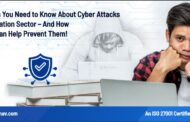Cybercriminals are known to treat all businesses alike, whether it’s a large enterprise or a small medium-sized enterprise, everyone is in the crosshairs of the cybercriminals. However, small businesses are more vulnerable than the rest as they do not have both the knowledge and the resources to ameliorate the complex threats arising from the cyberspace. Hence, it is said that defending the small and medium enterprise (SME’s) is perilous, yet not impossible.
A lot of SME’s think that due to their small stature in the market they are not susceptible to cyber-attacks and hence they don’t have a cyber-crisis plan in place. Consequently a majority of these SME’s face litigation from stakeholders and clients after the occurrence of a security event.
So how can these smaller entities protect themselves?
When a business suffers through a cyber-attack, there are two avenues available to them. They can either pay the ransom or hope that they can buy back the encryption code from the attacker or erase all the current data and restore it from the last time they had taken a backup.
Larger organizations do frequent backups of their data, no matter how large it is and hence they stand in a better position to counter the attack, should it arise. However, smaller organizations perform backups less frequently on a more erratic basis and are left with lesser options to tackle the threats.
In such a scenario, business owners are advised to be careful before they pay any sorts of ransom to the attackers. Since there is no guarantee that paying the ransom would result in the release of their data. Such a decision would only boost the morale of the attacker, which could also lead to a second attack being carried out on the same entity.
Mount a defense against the attack.
One of the most cost-effective ways to mitigating the risk of an attack is through effective employee training. Since, most of these attacks occur due to human error, as some or the other employee must have clicked on an unsafe link or enabled a macro in an attachment in some mail. Given the human element remains the most vulnerable link in a company’s cyber security plan, organizations should pay attention to educating their employees on how they can help strengthen the company’s security chain.
No businesses should ever ignore or undermine the importance of an adequate security protection, both physical as well as in the form of Antivirus software. They should ensure that proper firewalls, along with an updated version of the antivirus, especially one which has features like anti-spam, anti- malware and anti-ransomware in place. Unfortunately, it is seen that SME’s rely heavily on outdated and free Antivirus software’s that don’t provide adequate protection.
In the event of litigation, cost related to loss or restoration of data, loss of profits, possible fines or penalties that could amputate the progress of the company, it is advised to have a cyber-insurance cover in place that would protect the business against any legal costs.
Have a security policy.
It is advised to have someone look after the company’s security, even if it’s an external consultant, who would help string a cyber-insurance policy that would be a combination of cyber risk mitigation services and comprehensive insurance coverage. The policy should include ongoing, non-intrusive vulnerability scans on the company’s IP addresses as well as the boots that happen on the ground.
This gives businesses the ability to detect digital anomalies and act on them before they cause any harm to the business. Insurance, in this case, becomes the last resort when other methods of risk mitigation have failed.
To read more, please check eScan Blog







